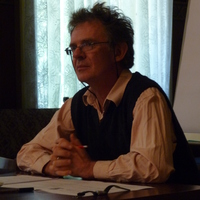
Jens Hoyrup
Related Authors
Daniel D. Hutto
University of Wollongong
Galen Strawson
The University of Texas at Austin
Judith L Green
University of California, Santa Barbara
Steven Pinker
Harvard University
E. Wayne Ross
University of British Columbia
Alejandra B Osorio
Wellesley College
David Seamon
Kansas State University
Shaun Gallagher
University of Memphis
John Johnson
Pennsylvania State University
Florin Curta
University of Florida










Uploads
Papers by Jens Hoyrup
research tradition in arithmetic”. So far, no continuation of this tradition has been known,
but analysis of three sections of two Latin works suggest that they borrow material that
can hardly come from elsewhere:
1. The Liber mahameleth, likely to be a more or less free translation made by Gundisalvi
or somebody close to him of an Arabic original presenting “mu a¯mala¯t mathematics vom
höheren Standpunkt aus” contains systematic variations, for instance of proportions :: p
g
P
G
(claimed to deal with prices and goods), where the givens may be sums, differences,
products, sums or differences of square roots, etc., solved sometimes by means of algebra,
sometimes with appeals to Elements II.5–6, often after reduction by means of proportion
techniques.
2. A passage in Chapter 12 of the Liber abbaci first presents the simple version of the
recreational problem about the “unknown heritage” (likely to be of late Ancient or
Byzantine origin): a father leaves to his first son 1 monetary unit and 1/n of what remains,
to the second 2 units and 1/n of what remains, etc.; in the end, all get the same, and nothing
remains. Next it goes on with complicated cases where the arithmetical series is not
proportional to 1 – 2 – 3 ..., and the fraction is not an aliquot part. Fibonacci gives an
algebraic solution to one variant and also general formulae for all variants – but these
do not come from his algebra, and he thus cannot have derived them himself. A complete
survey of occurrences once again points to al-Andalus.
3. Chapter 15 Section 1 of Fibonacci’s Liber abbaci mainly deals with the ancient theory
of means though not telling so. If M is one such mean between A and B, it is shown
systematically how each of these three numbers can be found if the other two are given –
once more by means of algebra, Elements II.5–6, and proportion techniques. The lettering
shows that Fibonacci uses an Arabic or Greek source, but no known Arabic or Greek work
contains anything similar. However, the structural affinity suggests inspiration from the
same environment as produced the Liber mahameleth.
So, this seems to be a non-narrative, a story that was not revealed by the participants,
and was not discovered by historians so far.
Chambon, Grégory: Normes et pratiques: L’homme, la
mesure et l’écriture en Mésopotamie. I. Les mesures
de capacité et de poids en Syrie Ancienne, d’Ebla à
Émar. Gladbeck: PeWeVerlag 2011. 200 S. 8° = Berliner
Beiträge zum Vorderen Orient 21. Hartbd. € 29,80. ISBN
978-3-935012-08-9.
Anne-Marie Vlasschaert, Le Liber mahameleth: Édition critique et commentaires. (Boethius: Texte und Abhandlungen zur Geschichte der Mathematik und der Naturwissenschaften 60.) Stuttgart: Franz Steiner, 2010. Pp. 184 (commentary), 429 (edition).
€74. ISBN: 978-3-515-09238-2.